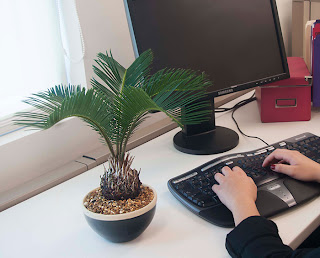Episcias are related to the
African Violets, their foliage and flowers add brightness to an office.
Episcias, sometimes listed as “flame” or “trailing” violets, have a magnificent range of foliage and flower color with leaves of shiny green, bronze and silver and tubular flowers of white, yellow, lavender, pink or red.
Added to these attractions is their charming manner of growth. Each plant sends out strawberry-like runners (stolons) which trail over the edge of the container.
There are about ten species of episcia plants and many more varieties.
Bronze-leaved, red-flowered Episcia cupreata is apt to be a shy bloomer but it has many varieties which produce an abundance of flowers with glistening green leaves and orange-red flowers. Established plants display flowers throughout the entire year.
Then there are Adajou with a pattern of silver green on a dark brown background and “Chocolate Soldier”, a favorite with many indoor growers, featuring chocolate brown leaves marked with silver centers. Silver Sheen displays red flowers above its frosty gray and brown leaves. Another cupreata variety called “Tropical Topaz” with green leaves and buttercup yellow flowers.
Let’s look at care and culture of Episcia…
1. Planting Episcia
Grow espiscias in a spongy soil, like those for African violets.
If you make up your own soil use two parts peatmoss, one-half part perlite or vermiculite and one-half part sand. One-half inch of pot chips and an equal amount of charcoal should be used as drainage for each four-inch pot. Keep the bulk of the runners pinched off to insure a good floral crop.
Many favor episcia containers which are long ceramic planters, soup tureens or aluminum cake tins with drainage holes punched in them. As the runners appear, they fasten themselves to the earth. When the container is full, let a few runners dangle over the edges. Since this container is filled with plants of varied ages, it shows bloom every month of the year.
2. Lighting and Temperature Requirements
Episcias thrive in an east, southeast or partially shaded south window. If you want them for foliage effect only, you can grow them to perfection in a north window or under grow lights.
Growing Under Office Lighting, Burlington, MA.
If you are growing plants indoors under artificial light like fluorescents episcias are just the thing to add to this garden. Under this non-changing light intensity they grow gorgeous foliage and bloom profusely.
The average interior office temperature, 72 to 75 degrees during the day with the usual five to 10 degree drop at night, seems to suit them. All episcias need more water than African violets and they grow best under fairly humid conditions.
If the air in yourindoor office workplace is too dry (under 40 degrees humidity) episcias and all of your house plants will benefit when set on trays of pebbles with water kept just below the pot line.
3. Fertilizing Episcias
Fertilize episcias twice a month with any good soluble liquid fertilizer, remembering, of course, to fertilize only on well moistened soil. This safeguards tiny roots from fertilizer burn. Keep episcias pest free by giving them a thorough inspection for pest.
4. Propagation
If older episcia plants have shed leaves and look straggly, trim off the runners and repot the old plant. You can start new plants From the pieces.
Propagate episcias from leaves, runners or seed. Boot leaves and runners in water, vermiculite, sphagnum moss or sand. Speed up root formation by covering them with a small glass or clear plastic cup to increase humidity.
You can get infinite foliage and flower variety by growing episcias from seed. Sprinkle the seed on moistened sphagnum moss or vermiculite. They germinate in ten days to three weeks and as soon as the little plants have four good leaves prick them out and plant them in a pot or flat. Given good growing conditions, they will flower from seed in eight to 12 months.
5. Episcia As Conversation Pieces
If you want to turn some of your episcia plants into conversation pieces, try some of these ideas.
1. Use any of the episcias as trailers in the foreground of a planter, using taller upright plants in the background.
2. Grow two or more kinds of episcias in a large pot with the background plants trained up a moss-filled “totem” pole or a porous piece of tree stump or root. As a starter fasten the episcia runners to the pole with green wire Twist-ems. Keep the support moist and the episcia roots will grow into it.
3. Plant episcias in moss-filled baskets and hang them in your window garden or greenhouse or summer them on the terrace.
4. Try a plant in a rose bowl or small aquarium. Here, with the added humidity they receive, they grow as lush as they would in their homeland.
5. Grow some episcias in an attractive container filled with water. Change the water once a week, give them medium light and a wee pinch of plant food and you’ll enjoy them on an occasional table or the mantel. And you may find yourself using them for a hurry-up centerpiece.
At
PDI Plants we always use different and exciting colorful flowers in your Burlington, MA indoor office environment.



















